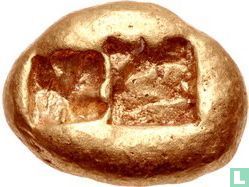

Enlarge image


Catalogue information
LastDodo number
2265923
Area
Coins
Title
Lydia Sardes King Croesus AV heavy Stater about 560-546 B.C.
Country
Face value
Year
-560
Variety / overstrike
Head of State
Type
Designer
Series
Theme
Material
Gold- or silver content
Weight
10.7
Diameter
17
Thickness
Punch
Shape
Obverse
Hoofd van een leeuw met zon op voorhoofd tegenover een stierenkop
Reverse
Twee incuse rechthoekige vormen, onregelmatig
Edge
Privy mark
Mint mark
Number produced
Krause and Mishler number
Catalogue number
Berk 1; McClean 8635
Details
The 'Kroisos' type coinage is one of the most recognizable of all ancient Greek coinage. All of the issues in the bimetallic, gold and silver, series feature the same confronted lion and bull foreparts on the obverse, and two incuse punches (or a single punch in the case of small denominations) on the reverse. It is thought that the series began around 560 BC, on a 'heavy' standard, with gold and silver staters of equal weight, around 10.6-10.7 grams. This standard was then reduced to about 8.17 grams, and the coinage continued, lasting into the first decades of Persian rule after the defeat of Kroisos in 546 BC. In addition to the heavy and light standards that establish a relative chronology, style adds another element, particularly for distinguishing the Lydian from the later Persian issues. The present coin is an example of how style can also be used as an element for determining chronology in the early, heavy-weight issues. The style of this stater, on a whole, is of the more 'realistic' character that is indicative of the earlier, pre-Persian issues of Kroisos, but differs from the norm in that the forelegs of the lion and bull are each bent at a 90 degree angle. While this may indicate a liberal license on the part of the engraver, the consistent appearance of the lion and bull on most staters and fractions suggests that the celators did not have much latitude in their choice of depictions. There is one element here, though, that is of paramount significance. On the head of the lion is a small pellet or protuberance. This feature is canonical on the earlier electrum coinage struck at Sardes from the time of Alyattes until the early part of Kroisos' reign. It was this electrum coinage that Kroisos replaced with his new bimetallic coinage. The fact that this feature is not found on the bimetallic coins of standard style strongly suggests that this coin is from the earliest issue of the bimetallic coinage, and provides a stylistic link to the previous electrum issues. The extreme rarity today of coins of this early style also suggests that this issue was short-lived, perhaps a trial run before the style was standardized.



